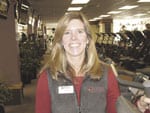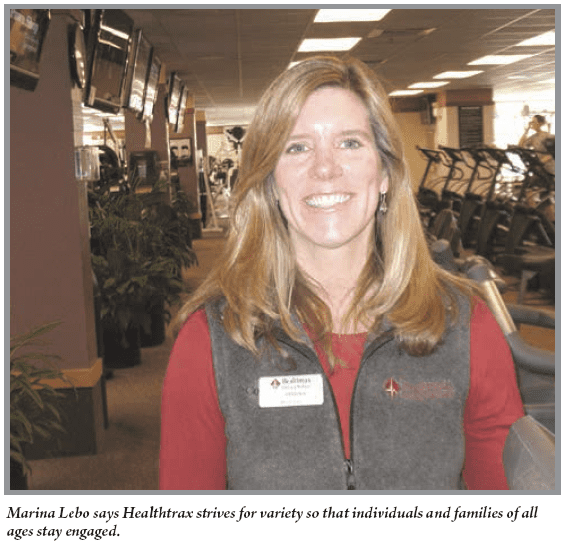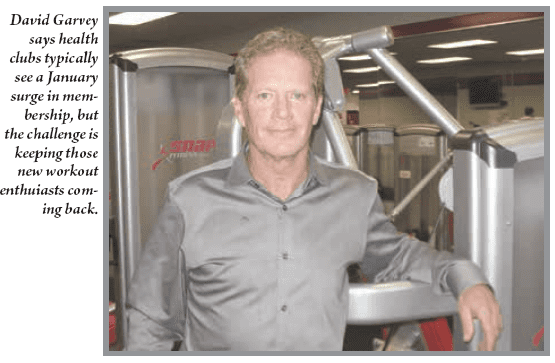Health Clubs Capitalize on Societal Focus on Wellness
A treadmill doesn’t make a very attractive coat rack, says Marina Lebo.
That’s one reason people looking to get fit join a health club — for a broad array of workout options to keep them motivated, without the prohibitive expense of buying every new fitness toy they see on TV.
“They want to make sure their fitness regimen includes variety,” said Lebo, general manager of Healthtrax in West Springfield. “That’s the biggest thing.
They might have a treadmill at home, but after three or four months, that gets pretty old, and it becomes a clothes hanger.”
The trick for health facilities — and it’s really no trick, but a science — is to keep members engaged and coming back long after the initial novelty of joining a club has worn off. “Even though the economy hasn’t been good, people’s awareness of fitness has allowed us to keep growing,” Lebo said, noting that the medical component — doctors prescribing physical-therapy work after surgery, for instance — as well as insurance coverage for fitness programs, are on the rise as well. “We haven’t had big upswings or big downswings, and we’ve been able to keep steady, which is unique in Springfield because of the amount of competition. Between health clubs,rehab sites, nutrition places, little studios that offer yoga … there’s so much competition.”
In fact, she noted, Greater Springfield has the highest number of health facilities per capita of any region in the nation. “We have the same number of health clubs as much bigger cities. But Massachusetts is also a pretty progressive state, and we have a higher percentage than most states of people who are fit and belong to health clubs.”
David Garvey took on that competitive landscape head-on when he opened Snap Fitness in Holyoke five years ago.
“When we initially started,” he said, “we attracted a lot of people just because of the concept: a smaller gym, a 24-hour gym, that didn’t compete with the big boxes but offered an alternative to them — where people could come in and use the best equipment in the industry, but without facing the big crowds.”
But the recession exacted a toll, he said. “Actually, 2012 was probably the worst year. We lost a good number of members,” Garvey said. Still, some who left to try out the big-chain options have returned, and he expects a strengthening economy to return Snap to a growth track.
“We’re not driven by big numbers; it’s more of a neighborhood gym,” he explained. “We have a couple of excellent personal trainers here who pay attention to members and help them. It’s not about driving the members to do personal training, but they’re there to help members accomplish their goals.”
That’s a development on the rise; in fact, jobs for fitness trainers are expected to rise by 29{06cf2b9696b159f874511d23dbc893eb1ac83014175ed30550cfff22781411e5} from 2010 to 2020, according to the American College of Sports Medicine (ACSM), making the field’s rosy labor outlook the number one entry in its annual survey of fitness trends, a list that also includes strength training, core training, programs aimed at senior citizens, and dance workouts like the ever-popular Zumba.
For this issue, HCN looks into the business of fitness — and how a greater societal emphasis on healthy living is painting a bright future for this competitive industry.
Stick with the Program
If gaining and then retaining members is a key goal for health clubs, each January brings new opportunities, thanks to an inevitable surge of new year’s resolutions — and suddenly gung-ho fitness adherents.
“There’s been a push since December, when membership starts to grow. It’s been busy through the holidays, and hopefully that continues,” Garvey said, noting that new memberships are often affected by weather, and a harsher winter will push more people to find an indoor workout option. “Certainly runners can be limited, so they’ll come spend a few months on a treadmill. So definitely, over the next few months, we’ll see a large increase in membership.”
Still, Lebo said, the January effect isn’t what it used to be.
“This business used to be very seasonal; you’d have a huge January and February, and a very slow July and August,” she explained. “But it’s not like that anymore. We’re still busier in January as people make resolutions, and the people who came twice a week start coming four times a week. But fitness has become more of a lifestyle than a luxury, and people do it on a regular basis. Sales still go up a little in January, and we have certain specials, but it’s more steady than it used to be, as people are more attuned to their lifestyle year-round.”
Many new members, unfortunately, don’t maintain their initial high level of enthusiasm. “They’ll come in January and kill themselves, and then you don’t see them until spring,” Garvey said.
“But it’s the gym’s responsibility to educate members,” he said, “and also educate them in the nutrition aspect.
You can’t come in here three times a week and expect to lose 20 pounds in a month if you don’t change your nutrition. A lifestyle change has to be made.”
Lebo credited Healthtrax’s orientation program with keeping newcomers excited. “That’s huge; if you start somewhere and buy a membership, and they say, ‘OK, have fun,’ what are the odds that you’ll stick with it? Here, you get three individual sessions with a trainer to go over your goals, your medical condition, everything you need to set up a program that works for you. It establishes a routine, makes you comfortable with the equipment.”
Staff-assisted Nautilus equipment helps people stay on course too, especially seniors who might not be comfortable with high-tech devices.
“There’s a comfort level knowing someone is there they can work with. That makes a big difference. At many places, you’re on your own, and there’s more risk of injury when you don’t know what you’re doing.” Still, the main factor in keeping members active — besides their concern for their own wellness, of course, may be variety.
“If you have more variety, you’ll use it more,” Lebo said, noting that Healthtrax also offers a broad array of fitness classes — from Zumba, pilates, and yoga to cycling, cardio, and aquatic fitness — aimed at all ages, including children, so families can make working out a group activity. “That’s a huge way to spend some time with the family, and everything is included in the membership. It also establishes a fitness routine for children that they can grow into as they grow up.”
It’s important, she added, to meet people’s specific needs, which is why small-group classes are targeted for everyone from triathletes in training to individuals getting in shape for ski or golf season.
There has also been growth in classes for senior citizens. Dr. Walter Thompson, a member of the ACSM administrative council and a professor of Exercise Science at Georgia State University, calls it one of the fastest growing niches in fitness.
“The Baby Boom generation is now aging into retirement,” he said, “and because they may have more discretionary money than their younger counterparts, fitness clubs should capitalize on this exponentially market.”
Indeed, as Boomers began to retire, Lebo noted, “we went from two water aerobics classes a week to four. And it keeps growing; more and more people in that age bracket are staying healthy and want to stay involved socially.”
The social element of a health club also helps people stay on track, she added, comparing it to the value people place in going to a movie or out to dinner, when a rental or takeout food is less expensive. “It’s that idea of getting out, going somewhere, the camaraderie. Plus, what else are you going to do here but work out? At home, you can think of 90 other things to do.”
At the Core
Lebo also pointed out an area of the Healthtrax facility devoted to core training — a space that has dramatically expanded in size as that discipline has become more popular.
“Core training stresses strength and conditioning of the stabilizing muscles of the abdomen, thorax, and back,” Thompson notes. “It typically includes exercises of the hips, lower back, and abdomen, all of which provide support for the spine and thorax. Exercising the core muscles improves overall stability of the trunk and transfers that to the extremities, enabling the individual to meet the demands of activities of daily living and for the performance of various sports that require strength, speed, and agility.”
Like with any hot trend, fitness clubs have had to adapt to incorporate core training in a broader way. “That’s become huge with a big demographic,” Garvey said. “It’s hardcore; it’s extreme. It uses your body weight, suspension training, rope training, agility. It’s not coming here and just lifting weights, or staying on an Arc Trainer for two hours, training the same muscles over and over.”
Core training, he said, offers something to just about everyone, from teens to older adults. “They might look at it and say, ‘this isn’t for me,’ but once they do it, it’s a rush. People love it. It’s revised the whole premise of exercise, and it’s probably the hottest thing in the fitness industry.”
One trend getting people more involved in fitness programs is the growth of worker-incentive programs, which many employers offer to promote good health — partially a response to rising healthcare costs experienced by companies, Thompson notes, adding that healthcare reform in the U.S. promises to place much more emphasis on preventative health. “Worker-incentive programs are associated with the trend to provide work site health-promotion programs in an attempt to reduce healthcare costs.”
Employee fitness benefits have fallen by the wayside in recent years at some companies, Lebo said, reflecting an overall cost-cutting trend by recessionbattered businesses. Still, “employees should ask their employers, ‘do you provide something like this, or will you?’ It’s a great benefit that a company can give, and not at a big cost.” It can even be a money saver, she added, because healthy employees are less likely to miss time or claim workers’ compensation.
In offering such incentives, workplaces provide yet another reminder of the importance of staying fit — a message that millions still need to take to heart.
“Yes, people are more aware, especially as they grow older, of the need to stay active, but there’s also this trend of inactivity.”
“The obesity rate in this country has never been greater,” Garvey said. “People don’t want to pass up junk food. So, yes, people are more aware, especially as they grow older, of the need to stay active, but there’s also this trend of inactivity.
“We see it every new year: people step up and get off the couch and say it’s time to do something,” he continued. “The challenge for those people is not getting into a rut in the gym, where they get bored and don’t get the results they need. You need to get people excited about doing different things, training different muscles.”
He added that he keeps Snap Fitness cleaner than the typical gym, which members appreciate. “Cleanliness is a big thing, and it’s probably the hardest part for any gym, no matter the size. And members appreciate it.”
Lebo said some out-of-shape people feel anxiety about working out in public, but many gyms make a point of creating an inclusive atmosphere, with dress codes and classes that appeal to all demographics. “We welcome everyone, at whatever fitness level they are. It really helps when someone feels like they belong and fit in. That’s what will motivate them to keep using it and get results.”
Bottom Line
Increasingly — and not just in January— out-of-shape individuals are responding.
“We’re reaching more and more of the population we’ve been trying to reach for years,” Lebo said. “We’ve got the healthy people coming, but more health clubs are starting to reach the people who really need us the most people coming off rehab, who have diabetes or high blood pressure, who are overweight and sedentary.
“It’s not that we don’t want to reach healthy people — we do,” she added. “But it’s nice to see that more and more people are making fitness a part of their lives.”
And clearing some space at home where that over sized coat rack used to be.





Comments are closed.